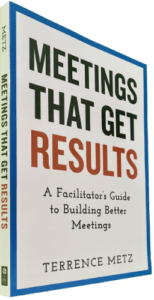 Meeting facilitation challenges vary depending on the specific context and the participants involved. However, some common facilitation challenges facilitators often encounter include:
Meeting facilitation challenges vary depending on the specific context and the participants involved. However, some common facilitation challenges facilitators often encounter include:
Conflict Resolution:
-
- Addressing conflicts or disagreements during a meeting represents a significant facilitation challenge. Facilitators need to prepare strategies that will manage any conflicts constructively. Facilitators are not responsible for resolving all conflict, but for managing it. The participants hold responsibility for resolving conflict, with proper guidance.
Dominant Participants:
-
- Dealing with participants who dominate discussions and prevent others from contributing can disrupt the meeting’s flow and effectiveness. Google discovered that its high-performance teams shared airtime equally among all team members.
Engagement:
-
- Keeping participants engaged and actively participating in the meeting remains a significant facilitation challenge. People may become disinterested or distracted during lengthy or unstructured meetings. The facilitator also wears the role of a process police person.
Follow-Up and Action Items:
-
- Ensuring that action items are documented and assigned remains the responsibility of the facilitator. However, the follow-up belongs to a different role, although it could be the same person. The facilitator must ensure that one and only one person will report back on the status of the assignment. However, when the sessions end, a different role ensures that the assignment is monitored, such as the project manager or product owner.
Group Dynamics:
-
- Understanding and managing group dynamics, including cliques or factions within the group, lends itself to a significant facilitation challenge. However, high-performance teams are frankly quite rare, and turn facilitators into scribes.
Lack of Preparation:
-
- Participants may not come to the meeting adequately prepared, which can hinder progress and effectiveness. This facilitation challenge is easily solved by putting the meeting purpose, scope, deliverable, and agenda in the meeting invite. Why would someone agree to attend a meeting if they don’t know the purpose?
Meeting Objectives:
-
- Ensuring that the session (meeting or workshop) achieves its intended objectives provides a significant challenge. Facilitators need to plan and guide the meeting to reach its goals. They also need to know what DONE looks like before the session begins.
Multicultural or Multinational Meetings:
-
- Many participants come from diverse cultural backgrounds and speak multiple languages. Understanding and preparing for potential communication and cultural barriers remains a huge facilitation challenge.
Remote Participants:
-
- In the era of remote work and virtual meetings, facilitating effective online or hybrid meetings comes with its own set of facilitation challenges. With many aspects to consider, common challenges include technical issues, limited non-verbal cues, and various distractions.
Time Management:
-
- Managing the meeting’s time effectively represents a clear facilitation challenge and responsibility. Striking a balance between allowing for meaningful discussion and staying on schedule requires thorough preparation. You cannot simply show up and be a great facilitator.
Facilitation Challenges Solved
We provide detailed Best Practices articles that provide tips and tools for dealing with each of these Facilitation Challenges. Below, you’ll find a summary of the corresponding “Solution” article and links to its sources.
Conflict Resolution:
Resolving conflict begins by understanding, clarifying, and confirming the purpose of the object of discussion and argument. If that appeal fails, active listening coupled with extensive challenges structures the discussion. Further appeals ask about the extent to which the purpose and objectives will be supported by the decision, especially the product, project, departmental, program, business unit, and enterprise objectives.
Dominant Participants:
“Proven Methods for Managing Any and All Meeting Conflicts” covers challenging personality types provides advice on managing challenging personalities in meetings and emphasizes the importance of maintaining a productive and respectful atmosphere. It suggests that problems in meetings often arise from certain individuals but highlights the need to avoid labeling them permanently as “problem persons.” Instead, it recommends identifying the cause of their disruptive behavior and offers a series of strategies for handling them. It also identifies several types of difficult participants and provides specific recommendations for dealing with each type, including dominant personalities such as loudmouths and monopolizers.
Engagement:
The article explains the concept of executive presence and provides tips on how to improve it. Executive presence is defined as a combination of qualities that convey confidence, authority, and the ability to lead. It encompasses factors like gravitas, communication, and appearance. The article breaks down the characteristics of executive presence into dimensions, traits, and factors, including credibility, clarity, warmth, and self-confidence.
Follow-Up and Action Items:
Daniel Pink’s book, “When: The Scientific Secrets of Perfect Timing,” emphasizes the importance of a productive meeting wrap-up, which he refers to as “ending on a high note.” Four critical activities combine for a clear and actionable meeting wrap-up: Review, Next Steps (Assignments), Communications, and Assessment. This article instructs on HOW TO wrap so that it sounds like all of your participants attended the same meeting together.
Group Dynamics:
“Don’t Run! How to Manage Meeting Conflict” emphasizes the importance of managing conflict in meetings and workshops for productive outcomes. It suggests that conflict, both internal and external, can lead to creative change and improvement when harnessed effectively. To manage meeting conflict, it recommends understanding group dynamics, especially the four stages of group development (Forming, Storming, Norming, Performing), and using appropriate leadership styles to navigate these stages. The article also encourages facilitators to employ visual aids, challenge established paradigms, and address groupthink for better decision-making. Finally, it acknowledges that people can change and offers specific activities to resolve conflict, such as appealing to a common purpose, active listening, appealing to objectives, and documentation.
Lack of Preparation:
“Meeting Preparation – How to Quickly Prepare Meetings for Results” outlines a comprehensive approach to meeting preparation, providing nine key activities and a basic agenda framework. It emphasizes the importance of thorough preparation for successful meetings and offers guidelines for structuring these activities.
Meeting Objectives:
“Meetings That Get Results,” presents the challenges of unproductive meetings and the importance of effective meeting leadership. It provides a practical guide for facilitating productive meetings. The book focuses on the objectives of decision-making, planning, and problem-solving. It emphasizes the significance of facilitation in making meetings productive and efficient. Given the busy schedules of professionals and the lack of formal training in meeting facilitation, it stresses the importance of having the right skills and tools to design and lead effective meetings, which can have a significant impact on an organization’s success.
“Meetings That Get Results” is designed for quick reference and cross-referencing, with lists and conventions for organizing information. It provides guidance on managing various types of meetings, emphasizing the importance of scripting the meeting purpose, scope, deliverables, and agendas along with providing support materials that ensure clear and actionable results.
Remote Participants:
“Online Meeting Problems (and Solutions)” explains common problems encountered during online meetings and offers solutions to address them. It mentions that these issues relate back to numerous causes, regardless of the specific video conferencing platform being used, and highlights the importance of addressing them to improve the overall meeting experience. The problems discussed include late arrivals, audio feedback, technical issues, interruptions, and distractions.
The suggested solutions emphasize the importance of effective communication, active listening, and respectful behavior among participants. It also highlights the need for skilled facilitators who can manage the flow of the meeting and maintain focus on the agenda. Additionally, the article suggests that organizations should invest in quality online tools and equipment to enhance the virtual meeting experience.
In closing, the passage emphasizes the need for better communication, leadership, and cultural norms in online meetings while also highlighting the importance of quality equipment and training for facilitators to improve the overall effectiveness of virtual meetings.
Time Management:
All the Best Practices articles focus on efficiency and time management, throughout the various stages of a meeting or workshop. “Don’t Just Start Meetings, LAUNCH Them in 5 Minutes or Less” on the essential activities for a successful meeting introduction will get you off to a roaring start with these seven activities, lasting no more than five minutes:
-
-
-
-
- Start with the End in Mind: Define the objectives of the meeting by describing what success looks like in terms of results or deliverables.
- Transfer Ownership: Emphasize the shared responsibility of the participants in achieving the meeting’s goals, using inclusive language like “we” or “us.”
- Visual Confirmation: Display the meeting’s purpose, scope, and deliverables visually to ensure clarity, and make sure they can be summarized in 25 words or less.
- Roles and Impact: Introduce the facilitator as neutral and highlight participants’ equal roles, emphasizing the importance of the meeting’s success and its potential impact on time or resources.
- Meeting Purpose: Clearly state the purpose of the meeting, seeking audible confirmation from participants.
- Meeting Scope: Describe the boundaries of the meeting, specifying what is included and what is not, while securing participants’ agreement.
- Meeting Deliverable: Explain what “done” looks like by presenting a prepared statement and obtaining agreement from participants.
-
-
-
Additionally, you will find optional activities for specific situations, such as icebreakers, updates from product owners or project managers, reviewing open items, and using a Plus-Delta feedback system for multi-day workshops. These activities should be conducted in a specific sequence to ensure a clear and compelling meeting introduction. Finally, the article guides how to handle executive sponsor contributions during select projects or product launches.
“LAUNCH” highlights the activities of a quick, yet structured meeting wrap-up and references other articles with details on conducting meetings quickly.
______
Don’t ruin your career by hosting bad meetings. Sign up for a workshop or send this to someone who should. MGRUSH workshops focus on meeting design and practice. Each person practices tools, methods, and activities daily during the week. Therefore, while some call this immersion, we call it the road to building high-value facilitation skills.
Our workshops also provide a superb way to earn up to 40 SEUs from the Scrum Alliance, 40 CDUs from IIBA, 40 Continuous Learning Points (CLPs) based on Federal Acquisition Certification Continuous Professional Learning Requirements using Training and Education activities, 40 Professional Development Units (PDUs) from SAVE International, as well as 4.0 CEUs for other professions. (See workshop and Reference Manual descriptions for details.)
Want a free 10-minute break timer? Sign up for our once-monthly newsletter HERE and receive a free timer along with four other of our favorite facilitation tools.
Go to the Facilitation Training Store to access proven, in-house resources, including fully annotated agendas, break timers, and templates. Finally, take a few seconds to buy us a cup of coffee and please SHARE with others.
In conclusion, we dare you to embrace the will, wisdom, and activities that amplify a facilitative leader. #facilitationtraining #MEETING DESIGN

Terrence Metz, president of MG RUSH Facilitation Training, was just 22-years-old and working as a Sales Engineer at Honeywell when he recognized a widespread problem—most meetings were ineffective and poorly led, wasting both time and company resources. However, he also observed meetings that worked. What set them apart? A well-prepared leader who structured the session to ensure participants contributed meaningfully and achieved clear outcomes.
Throughout his career, Metz, who earned an MBA from Kellogg (Northwestern University) experienced and also trained in various facilitation techniques. In 2004, he purchased MG RUSH where he shifted his focus toward improving established meeting designs and building a curriculum that would teach others how to lead, facilitate, and structure meetings that drive results. His expertise in training world-class facilitators led to the 2020 publication of Meetings That Get Results: A Guide to Building Better Meetings, a comprehensive resource on effectively building consensus.
Grounded in the principle that “nobody is smarter than everybody,” the book details the why, what, and how of building consensus when making decisions, planning, and solving problems. Along with a Participant’s Guide and supplemental workshops, it supports learning from foundational awareness to professional certification.
Metz’s first book, Change or Die: A Business Process Improvement Manual, tackled the challenges of process optimization. His upcoming book, Catalyst: Facilitating Innovation, focuses on meetings and workshops that don’t simply end when time runs out but conclude with actionable next steps and clear assignments—ensuring progress beyond discussions and ideas.




